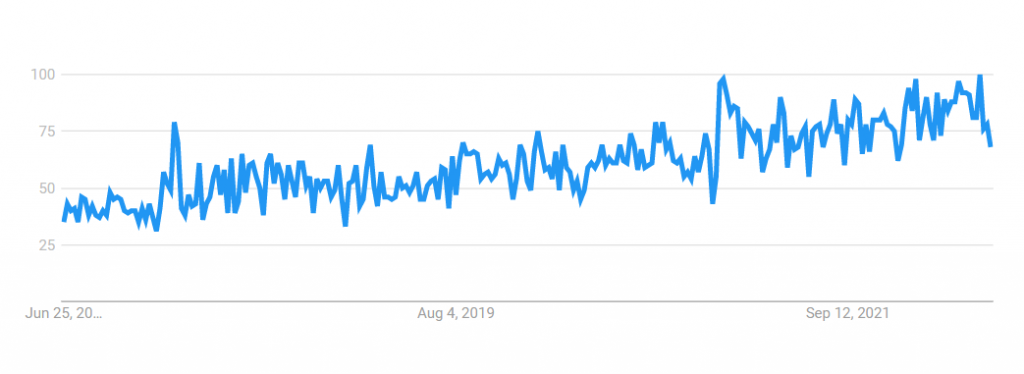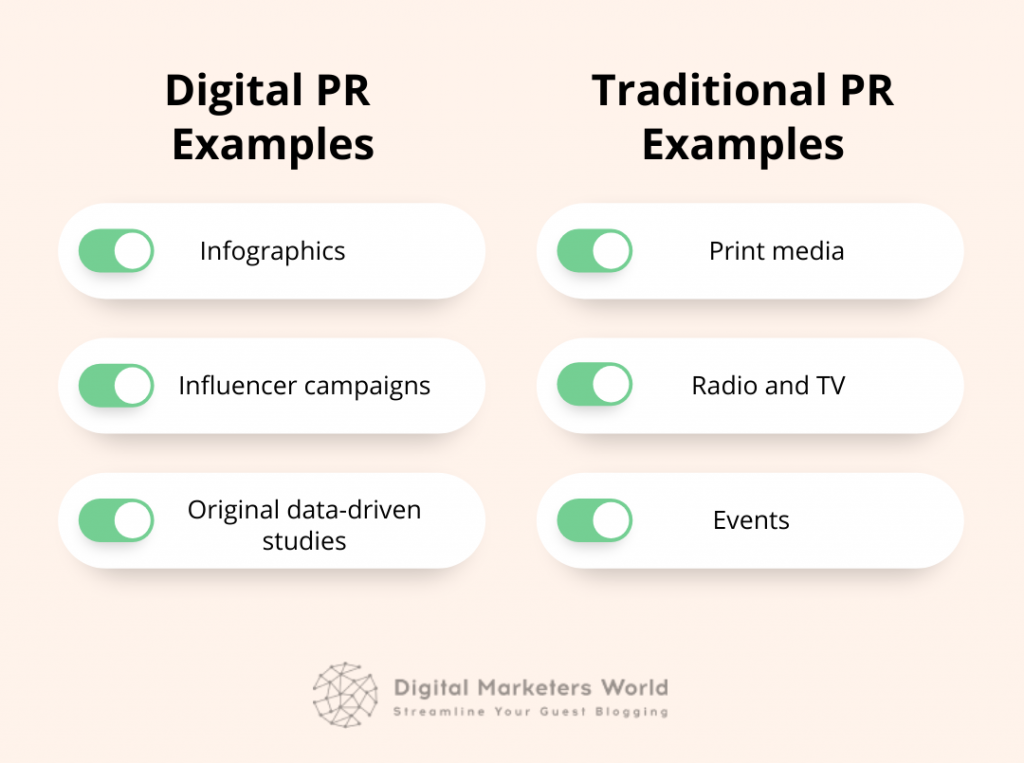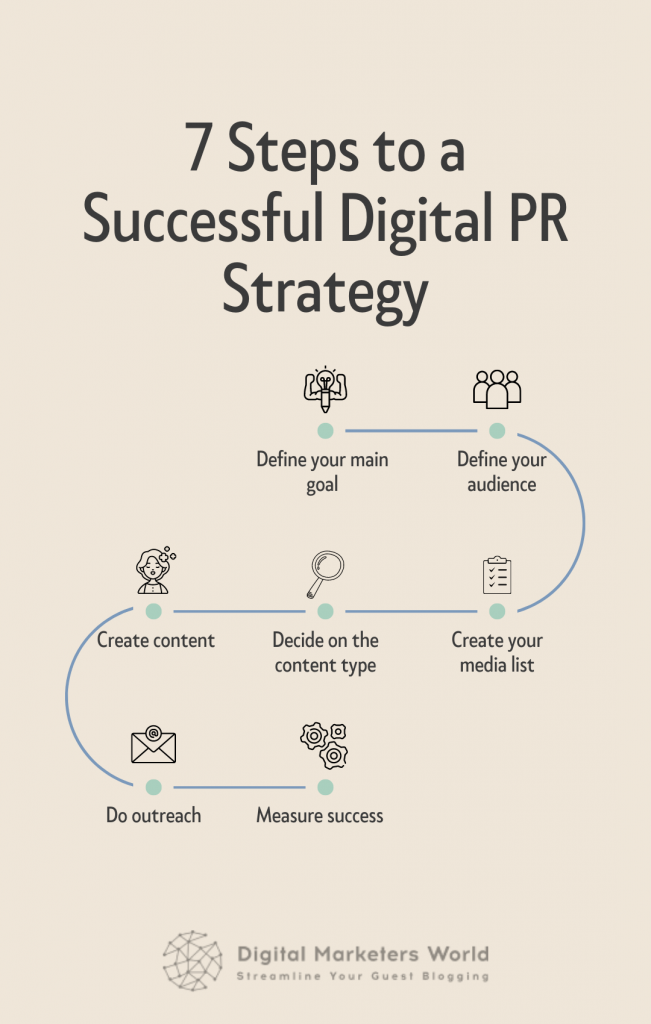What is Digital PR? [Definition, Tactics, Tools & More]
Managing the reputation of your brand is an important tactic for maintaining and increasing the success of your company.
As a relatively new way of reputation management for your business, Digital PR is the natural evolution of classic public relations adopted to the reality of the digital world.
Our guide will shed light on this discipline and help you get started with your own strategy.
What is Digital PR?
Digital PR is a subset of content marketing that focuses on publicizing your brand and increasing the positivity of public perception about you in the digital space, including blogs, journals, online news outlets, review sites, and aggregators.
Digital PR is becoming increasingly popular among many businesses, especially in recent years. We can see evidence of this interest on the Google Trends report for the keyword “digital pr” for the last 5 years:

Overall, Digital PR seems like a promising discipline, and up next, we will list the reasons why it is worth adding to your marketing stack.
Why is Digital PR Important? (With Benefits)
Digital PR is important because it focuses on a sustainable approach to reaching some of the most crucial business goals – building rapport and trust in your brand and products in the eyes of your target audience.
When you get leads that trust you, you can expect better conversion rates, revenue, and retention.
Now let us dig a bit deeper into the benefits you can expect with a digital PR strategy and understand the intricacies of each.
Benefit #1: Boosts SEO and search engine rankings
One of the important digital PR efforts is to build your backlink profile (here’s a list of agencies in case you consider outsourcing it).
Your backlink profile helps you increase your online presence and expose your brand to more people. But, other than that, it also significantly improves the search engine optimization of your website.
Backlinks are one of the most important ranking factors for search engines. When you manage to obtain links pointing to your website or content from lots of other sites with high authority and reputation, you can expect to get higher ranks on search engine result pages. In turn, higher search rankings on target keywords will directly translate to more organic traffic to your website.
Benefit #2: Increases brand awareness
The term ‘public relations’ in the name of digital PR speaks for itself. Digital PR’s primary goal is to get more people to recognize you and make sure that everyone trusts and loves your brand.
Let’s focus on the “more people recognizing you” aspect now. Digital PR experts will collaborate with various journalists, bloggers, and influencers to help promote your brand. These promotions can be in the form of writing an article or news piece about you or simply mentioning your brand in their regular content.
In both cases, these media mentions add the number of people who recognize your brand and company to your target audience .
Benefit #3: Builds trust
Continuing from the second benefit above, the next aspect that digital PR focuses on is trust. It is worthless to have thousands or millions of people who recognize your brand but do not trust you.
Thus, your digital PR team will ensure that the bloggers and journalists talking about you represent your brand from the best angle. They will also pay attention to the reputation of these publishers to make sure that only the best ones are promoting you.
Overall, digital PR specialists will do everything so that your brand name equals a high level of authority and trustworthiness in the minds of your target audience.
Benefit #4: Generates leads
If you do your digital PR right, your website and products should appear in front of the relevant people with the needs and interests that match what your company offers.
Making sure your brand’s promotions reach your target audience is also a key part of a digital PR specialist’s job. Both in link building and publicity with journalists/blogs, they are reaching out to only those operating in a niche relevant to your company and have an audience that will find your products useful.
The combination of brand awareness, trust, and targeting relevant people results in an increase in the number of leads you get. However, it is not only the number of prospects that increases, but also the quality, as these people are genuinely interested in you and your products/services.
Benefit #5: Helps in increasing sales
Continuing on the ideas mentioned in the previous benefit, when digital PR helps you generate quality leads, these leads will also result in better sales revenue.
The reasons here are the same – your leads are people who trust you and have relevant needs. Thus, it is natural for you to expect higher conversion rates from these prospects compared to others, and higher conversion rates lead to more sales revenue.
To conclude, implementing digital PR for your company will be a highly-beneficial decision, thanks to its ability to build brand awareness and rankings and generate high-quality leads.
Coming up next, let us clear up any possible confusions you might have with the term PR by comparing digital PR with classical public relations.
What is The Difference Between Digital PR and Traditional PR?
That’s right, both digital PR and traditional PR are about public relations. They both share the same eventual goals of increased reach and trust in your brand.
But the approaches they take to reach these goals are significantly different from each other.To clarify these differences, let us compare examples of digital PR and traditional PR side-by-side.

Essentially, digital PR focuses on online promotional means, while traditional PR uses a mix of digital and traditional marketing.
Now, let us break down the types of content for both digital PR and traditional PR.
Digital PR examples
As the name suggests, the assets of this discipline all live in the digital world.
Some of the most prominent examples of digital PR are:
- Infographics: a common deliverable that digital PR experts love. There are two reasons why infographics work. Firstly, they are rich with visuals that increase readability and traffic (visual content gets 94% more views). Secondly, infographics get lots of natural backlinks as other content creators reference your data.
- Influencer campaigns: another favorite channel for digital PR, as your teams will take advantage of the popularity and trust that social media influencers enjoy to promote your company with reviews, brand mentions, and more.
- Original data-driven studies: making your own studies is a great strategy for obtaining high-quality backlinks and getting journalists to talk about you. By doing original research, you are able to come up with statistics and findings that are relevant and useful to everyone in your niche.
With the digital PR deliverables clear to us, let us move on to its traditional counterpart and explore some of its examples.
Traditional PR examples
Traditional PR experts mainly rely on channels and media outside the digital world.
Here is where traditional PR experts will do their online marketing campaigns:
- Print media: the good old physical newspapers and journals. Despite what you might think, print publications are still highly relevant, with a $26.5 billion market size. Traditional PR experts praise print media for its credibility and trust.
- Radio and TV: PR here appears in the form of both ads and your company’s appearance in a talk show, news story, etc. Digital PR specialists like TV and radio because of their wide reach.
- Events: here, we can have both events organized by 3rd parties where your brand appears in a booth or as a sponsor, or when you are making your own events and inviting others.
To sum up, both digital public relations and traditional PR seek the same eventual goals, but they are using vastly different media for that purpose.
Now let’s move on to the types of digital PR and understand their main intricacies.
3 Main Types of Digital PR
We mentioned several deliverables that are common for digital PR campaigns. But to understand when and why digital PR agencies or teams need them, you need to be familiar with the general strategies of this discipline.
Among the many approaches that digital PR experts take, these three types are the most common:
- Link building: the process of obtaining backlinks from high authority sites on the internet to increase your reach and improve SEO rankings. Digital PR teams will reach out to websites with off-page SEO tactics such as link placement or quality content (guest post) writing offers and make compelling content to attract natural backlinks.
- Social media: digital PR experts actively use social media channels (e.g., LinkedIn, Twitter) to increase your brand image and maintain it. They will run influencer campaigns, manage communities of users, and protect your brand’s reputation with crisis management.
- Press releases: these are compelling news stories prepared by Digital PR teams to spark the interest of journalists and increase media coverage. If done right, the news outlets in question will feature your brand in their content.
In summary, link building, social media, and press releases are among the most important aspects you should pay attention to when building your own digital PR strategy.
Now it is time to switch from high-level types and strategies to low-level digital PR tactics and tips and cover that side for you too.
4 Digital PR Ideas & Tactics that Work
In the world of digital PR, there are no boundaries and fixed lists of tactics. Essentially, any hack or action that helps you reach your PR goals is acceptable.
However, there are still best practices and well-tried approaches that are commonly used in this field, and we have compiled a list of four of these for you to consider.
1. Create an industry-specific study
We touched upon this point in the Digital PR examples already. Thus, let us focus more on a use case to solidify your knowledge of it.
The case we want to highlight is about Ahrefs with its great reputation for making compelling original studies.

The study above is about Google’s ranking process. The team at Ahrefs took their time and put significant efforts into gathering and analyzing data about Google’s behavior to make this piece.
As this study is quite valuable to SEO experts and digital marketers, Ahrefs will benefit significantly from it in the form of natural backlinks, press, influencer mentions, and more.
2. Leverage newsjacking
Newsjacking is about taking advantage of current news or trends to promote your brand and products.
One of the most memorable examples of newsjacking done right is about the breakup of Brad Pitt and Angelina Jolie.

Norwegian Airlines used this breaking news to promote its flights to Los Angeles by mentioning that Brad Pitt is now single and travelers can take their chances.
3. Create infographics
As mentioned earlier, infographics are another common tactic for digital PR teams, thanks to their ability to create natural backlinks.
An example of a great infographic that serves this purpose is SocialMediaToday.com.

SocialMediaToday prepared an interesting and valuable visual report on influencers and influencer marketing and posted it on their website.
Thanks to the many useful statistics included there, many 3rd party websites will mention it in their own posts and give quality links.
4. Team up with influencers
Social platforms are personal in nature, and people following influencers feel a certain degree of personal connection with them.
Digital PR experts capitalize on this by partnering up with influencers and making them brand ambassadors or simply getting them to review and promote your brand and products.
We hope that you will find these tips helpful when you decide to create your digital PR marketing strategy. And while we’re on it, we have a set of steps to help you with that matter.
How to Create a Digital PR Strategy in 7 Simple Steps
Considering the multitude of benefits that brands enjoy after implementing a digital PR strategy, you might want to start it in your team or company too.
For this case, feel free to take advantage of the steps we have outlined below for a successful digital PR strategy.

Now let’s go over each step and discuss the details.
Step #1: Define your main goal
Before starting anything, you should consider defining and setting your goals.
Digital PR teams commonly set goals such as extra traffic for your homepage, building an email list, and increasing brand awareness or trust.
Step #2: Define your audience
Ideally, you need to know the demographics, interests, location, and needs of the people you want to target, as it will directly influence both the content you create and the exact publications/influencers you need to collaborate with.
Step #3: Create your media list
In terms of filtering out relevant online media outlets, you can take into consideration two factors – the relevance of their audience (how well they match your personas) and their size.
Step #4: Decide which type of content to create
Thanks to the personas you have made in step 2, you should have a solid idea of what piece of content to create to attract their attention.
B2B professionals will enjoy a data-driven case study, while in B2C entertainment, you might consider something more fun and engaging.
Step #5: Create your content
Now it is time to set up a content marketing workflow for your team and start the actual process of digital content creation.
You can choose to make it either in-house or to delegate that task to specialized companies and professionals outside your brand.
Step #6: Outreach
With your content and shortlist of media outlets ready, you can go ahead with reaching out to them via press releases, content pitches, offers for link placement, and other tactics.
Step #7: Measure your success
Finally, you need to set a group of metrics and digital PR KPIs to help you measure your performance and understand how close you are to reaching your goals.
In case you are not sure what to measure, our next section will guide you through the most common online PR KPIs.
5 Metrics to Measure the Success of Your Digital PR Campaigns
Some important metrics you can use to measure the success of your digital PR campaigns are the following:
- Number of backlinks: by counting the new do-follow and no-follow backlinks you have obtained from your campaigns.
- Average domain authority of the backlinks: this indicates the quality of your backlink profile and the trust level of the websites that have mentioned you.
- Referral traffic: indicating the number of website visitors you got from your backlinks.
- Social media engagement: including likes, social shares, and comments of your partner influencer posts and those of your own.
- Number of online mentions: how many times publications and influencers have mentioned you online.
There are also the regular KPIs you can track like website traffic, CTR, CR, and others.
Finally, the last aspect we want to cover for you on digital PR is the toolset to make your life easier.
4 Digital PR Tools to Make Your Campaigns a Success
There are lots of tools that digital PR teams use every day. The ones we want to highlight are some of the most valuable:
- HARO: Helping you find and contact reporters.
- BuzzSumo: letting you get content ideas and filter and reach out to influencers.
- Google Analytics: a free tool for comprehensive tracking and analytics.
- Majestic: used for backlink analysis and monitoring.
You can also consider other regular digital marketing tools such as Semrush, HubSpot (or its alternatives), tracking tools, platforms for capturing customer reviews, and others.
Now Over to You
Despite being a relatively new discipline derived from content marketing, digital PR has become significantly popular thanks to the value it brings to brands in terms of better reputation, trust, lead generation, and better rankings.
We regularly cover interesting topics on digital marketing. Take a look at our blog for more.

Sona Kalantaryan is a senior digital marketer with a creative past. Big fan of high cinema and well-optimized landing pages. She authors guides by sharing the best practices and does it the right way!
